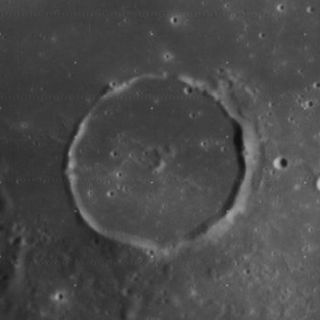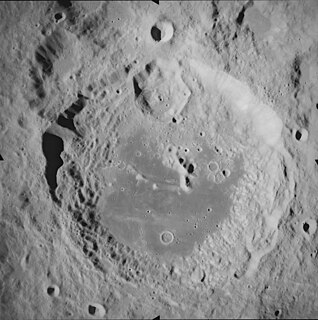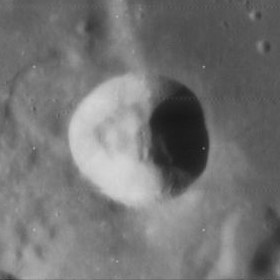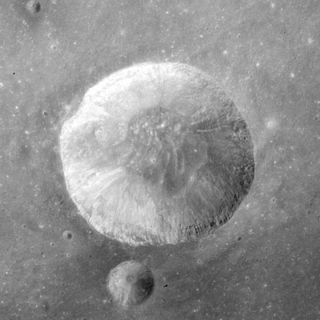
Puiseux is the remnant of a lunar impact crater that has been almost completely submerged by lava. It was named after French astronomer Pierre Puiseux. It is located near the southern end of Mare Humorum, to the north east of the ruined crater Doppelmayer. To the south-southeast is Vitello. Of the original structure of Puiseux, only the upper part of the rim remains above the mare surface. There are some small craterlets within the interior floor.

Aitken is a large lunar impact crater that lies on the far side of the Moon, named for Robert Grant Aitken, an American astronomer specializing in binary stellar systems. It is located to the southeast of the crater Heaviside, and north of the unusual formation Van de Graaff. Attached to the southwest rim is Vertregt. To the southeast is the smaller Bergstrand.

Cardanus is a lunar impact crater that is located in the western part of the Moon, in the western part of the Oceanus Procellarum. Due to its location the crater appears very oval because of foreshortening, and it is viewed almost from the side.

Cavendish is a lunar impact crater that is located in the southwest part of the Moon, to the southwest of the larger crater Mersenius. It lies between the smaller craters Henry to the west-northwest and de Gasparis to the east-southeast.

de Gasparis is a lunar crater that is located in the southwest part of the Moon. It lies to the southwest of the crater Cavendish and south of Mersenius.

Doppelmayer is the remains of a lunar impact crater that lies on the southwest edge of Mare Humorum. It was named after the German mathematician and astronomer Johann Gabriel Doppelmayr. To the south-southeast is another flooded crater designated Lee, and to the southeast is Vitello. Just to the east-northeast of Doppelmayer lies the nearly submerged crater Puiseux.

Hippalus is the remnant of a lunar impact crater on the eastern edge of Mare Humorum. It was named after ancient Greek explorer Hippalus. To the southeast is the crater Campanus, and to the northwest is the small flooded crater Loewy.

Agatharchides is a lunar impact crater located at the southern edge of Oceanus Procellarum, in the region between the Mare Humorum and Mare Nubium. To the east-southeast is the crater Bullialdus, and to the south-southwest lies Loewy. It is named after the Greek geographer Agatharchides.

Archytas is a lunar impact crater that protrudes into the northern edge of Mare Frigoris. To the northwest is the comparably sized crater Timaeus, and the smaller Protagoras lies in the opposite direction to the southeast. Further to the southwest, beyond the opposite edge of the mare, is the dark-floored crater Plato.

Boss is a lunar impact crater that is located along the northeast rim of the Moon's near side. Due to its location, the crater is viewed from the side by observers on the Earth, and its visibility is subject to libration effects.

Fizeau is a prominent lunar impact crater that is located on the far side of the Moon, in the southern hemisphere. Nearby craters of note include Minkowski to the west-northwest, and Eijkman to the southwest.

Bellot is a small lunar impact crater that is located on the southwest edge of Mare Fecunditatis. It lies between the craters Goclenius to the northwest and Crozier to the southeast. To the southwest is Colombo, and to the west is Magelhaens.

Black is a small lunar impact crater that lies just to the southeast of the walled basin Kästner. To the south-southwest is the crater Ansgarius, and to the east is the small Dale. It is located near the eastern limb of the Moon, just to the southwest of the Mare Smythii.

Carmichael is a lunar impact crater that is located along the eastern edge of the Sinus Amoris, in the northeastern quadrant of the Moon's near side. Its diameter is 20 km. It was named after American psychologist Leonard Carmichael. It lies within a couple of crater diameters south-southwest of the smaller crater Hill. Further to the east-northeast is the prominent crater Macrobius. Carmichael was designated Macrobius A before being given its current name by the IAU.

Loewy is a small lunar impact crater that lies along the eastern rim of Mare Humorum, in the southwest part of the Moon's near side. It was named after French astronomer Maurice Loewy. This is a lava-flooded formation that lies to the southwest of the larger, lava-flooded crater Agatharchides. To the southeast is an even larger lava-flooded formation, Hippalus.

Vitello is a lunar impact crater that lies along the southern edge of the small Mare Humorum, in the southwest part of the Moon's near side. It was named after 13th century Polish theologian and physicist Vitello. It lies just to the east of the lava-flooded crater Lee. To the northeast along the edge of the lunar mare is the Rupes Kelvin, an irregular fault line.

Crozier is a lunar impact crater that is located on the southwest edge of Mare Fecunditatis, a lunar mare in the eastern part of the Moon's near side. It lies to the east-northeast of the prominent crater Colombo, and southeast of the small crater Bellot.

Ibn Battuta is a small lunar impact crater on the Mare Fecunditatis, a lunar mare in the eastern part of the Moon's near side. It lies to the southwest of the crater Lindbergh, and northeast of the prominent Goclenius.

Palmieri is a lunar impact crater that lies to the southwest of the Mare Humorum, in the southwestern quadrant of the Moon's near side. It lies due south of the crater Liebig and east-northeast of the larger Fourier.

Fourier is a lunar impact crater that is located in the southwestern part of the Moon's near side, just to the southeast of the crater Vieta. To the northeast is the Mare Humorum. The rim of this crater is roughly circular, but appears oval when viewed from the Earth due to foreshortening.






























